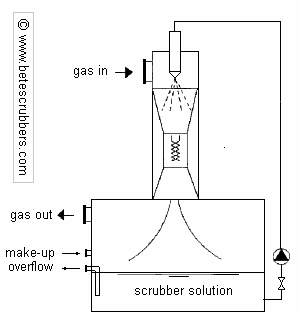 |
| Venturi scrubber diagram Credit: betescrubbers |
Of course, we had a scrubber to remove the off-gassing sulfur dioxide and HCl. It was a ridiculous contraption, made of cheap PVC pipes, strapped to a plastic-lined steel 55-gallon drum with a pumping system. I realize now, looking back, that it was supposed to be a homemade Venturi scrubber. So it's with some level of dismay that I recently consulted The Pilot Plant Real Book to see what it had to say about scrubbers:
Proper design of a scrubber is quite complex and involves a good understanding of mass transfer, Henry's law, gas/liquid diffusivities, etc. Performance must be maximized while keeping the unit size small as practical and minimizing foaming and other operational problems. Chemical compatibility of components is critical. An in-line heat exchanger will allow temperature control should it be necessary to remove reaction heat or to warm the solution to prevent freezing out outside units or to improve extraction efficiency. For any scrubber of appreciable size, environmental permitting will no doubt be required.
Small commercial scrubbers are available from many supplies of chemical reactors and pumping equipment. Work only with experienced manufacturers, and be able to provide estimates of the required capacity and data on the types of substances that will be used. A small Venturi-type scrubber can be contracted for kilo-lab use, but it is important to understand its capacity, to use the same care in selecting the scrub solution as with any larger unit and to operate it only within a certified walk-in chemical fume hood.We, of course, had a scrubber that was too large to fit into a chemical fume hood. Between that and forgetting to recharge the scrubber solution with caustic (something that did happen a time or two), we occasionally would come in the morning to a laboratory that had a bit of an acrid bite to the air.
And then there was the time that we began to notice that the bolts in the ceiling were looking a bit rusty...

Vilsmeier's reagent!
ReplyDeleteGood times....Good times.....
DIY ventilation safety equipment is the reason why, in a chemistry department with a biblical plague of houseflies my graduate research lab was fly free ... or at least free of living houseflies.
ReplyDeleteso ChemEs may make valuable contributions to chemists after all!
ReplyDeleteEngineers: Figuring out how to make crazy scientists' ideas safe and profitable since the beginning of time.
ReplyDelete